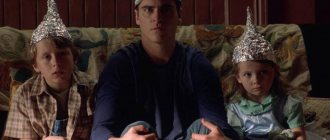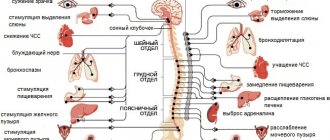An abnormal perception of the surrounding world and oneself, when everything seems unreal, and one’s own thoughts, emotions, sensations seem to be observed from the outside, is called depersonalization in psychiatry. Often it occurs along with derealization, characterized by the remoteness of everything around, the absence of colors in it, and memory impairment. Due to the similarity of symptoms, in the 10th revision of the International Classification of Diseases, depersonalization-derealization syndrome is designated by one code F 48.1.
Perception disorder affects more than 70% of people worldwide from time to time. It seems to them that their consciousness is divided into two parts and one of them, having lost control over their mind and body, panics, and the second indifferently watches this from the side. It's like a bad dream and therefore very frightening. A person sees everything in a fog, in muted colors, and cannot move either an arm or a leg. He feels extreme discomfort and feels like he is going crazy.
Experts do not consider this disorder a serious mental pathology. The human psyche can react this way to stress, fear, severe emotional shock, and even overwork in the physical sense. The brain “turns on” the defense, reducing a person’s sensory sensitivity and emotionality, so objects seem strange, unusual to the touch, and colors appear faded. That is, the perception of the world becomes unusual and strange, unfamiliar. This condition usually goes away on its own and quickly, without treatment.
But, if such a syndrome manifests itself frequently and lasts for a long time, and the symptoms intensify, then it is already dangerous: the individual can harm himself and others with his inappropriate behavior, or commit suicide. Therefore, in this case, the help of doctors is necessary.
You need to know that depersonalization can also accompany clinical depression, panic attacks, anxiety and bipolar disorders, and schizophrenia. Similar sensations are caused by narcotic drugs, sedatives and antihistamines and a number of other medications, as well as caffeine and alcohol.
Causes of perception disorder
Depersonalization occurs in people of different ages and genders, but most often it affects young women. As already mentioned, it is caused by a stressful situation. The psyche that resists it reduces the strong emotional load of a person, switching his attention to outside observation. Thus, the individual turns his consciousness inward, his senses become dulled, but logical thinking remains the same.
The process of development of the syndrome in the body looks like this: under the influence of stress, a large amount of endorphins begins to be produced. As a result of their large-scale chaotic attack on receptors, the limbic system responsible for emotions is unable to cope with such pressure and is forced to partially shut down.
But the above mechanism can also be triggered by other physical factors:
- stroke;
- hypertension;
- brain tumor;
- neurological disease;
- head injury;
- epileptic seizure;
- neurosurgical operation;
- severe infectious disease in childhood;
- birth injury.
Very rarely, depersonalization is inherited or is a consequence of negative changes in the nervous system.
It has already been said that taking drugs or other intoxication of the body can also cause a disorder of perception, as this provokes increased production of “hormones of happiness” - endorphins. Therefore, in the United States, an organization on drug addiction issues is studying depersonalization at the state level.
It should be noted that in schizophrenia, split personality has other causes and this is a symptom of a serious mental disorder, the approach to which is special and requires complex treatment.
Symptoms of postpartum depression
About 80% of first-time mothers experience problems with mood disorders. Typically, the mood disorder lasts up to 10 days, provided that the young mother receives care and attention. It is expressed by frequent mood swings, even for minor reasons, and a tendency to tearfulness. Of these, in 10% of cases, symptoms of postpartum depression can be long-lasting and develop into, in fact, a disease.
In most cases, early signs of postpartum depression go unaddressed. The disease itself can develop slowly and have a negative impact both in relation to loved ones and in relation to the child. About 13% of children in the first year of life are negatively influenced by a mother who is experiencing postpartum depression. In this state, the mother may be aggressive towards the child, be inattentive to his needs, and not show proper love and care.
Symptoms
There are 3 conditional groups of signs characterizing depersonalization syndrome:
1. Emotional coldness, indifference in the perception of the surrounding world, detachment, indifference to people::
- indifference to the suffering of others;
- lack of joy when communicating with family and friends;
- insensitivity to music;
- loss of sense of humor;
- maintaining equanimity in situations that previously aroused any feelings, both negative and positive.
Fear is experienced only from the loss of control of one's body and loss of orientation in space. The feeling of confusion from not understanding the location, the history of getting here and further actions is depressing.
2. Violation of physical sensations:
- Loss of sensitivity to hot and cold;
- colors become dull, color blindness may appear;
- taste sensations change;
- objects seem blurry and have no boundaries;
- sounds seem muffled, as in water;
- There is no pain with minor wounds;
- coordination of movements is impaired;
- There is no feeling of hunger, and with it the appetite disappears.
3. Mental immunity:
- a person forgets his preferences - what he likes and dislikes;
- lack of incentives and motives - reluctance to take care of yourself, cook food, do laundry, work, go shopping;
- temporary disorientation - an individual can sit without doing anything for several hours and not understand how much time has passed;
- the feeling of participating as an actor in a boring, drawn-out play;
- contemplation from the outside of your life, as if it were a dream.
The main sign of a perception disorder is a person’s deep self-absorption. At first he realizes that he perceives his personality incorrectly, this depresses him and causes strong emotional disturbance.
When trying to understand what is happening, the feeling of unreality becomes stronger, and the absurdity of the situation forces the individual to avoid communication with other people. The individual, however, is aware of the painfulness of his condition.
In general, the clinical picture of depersonalization can be described as follows:
- The perception of the world is disrupted - it seems unreal, fantastic.
- Complete detachment from what is happening around.
- Loss of satisfaction from natural physiological needs - sleep, food, defects, sex, etc.
- Closedness.
- Impaired perception of the structure of one's body - arms and legs seem artificial, of unknown configuration or size.
- Inability to control your body.
- Decreased intellectual abilities.
- Feeling of loneliness, abandoned by everyone.
- Absence of any emotional manifestations.
- Changes in physiological sensations.
- Split personality.
- The feeling of watching yourself from the outside.
These symptoms of perceptual disorder may have varying degrees of severity for different types of depersonalization, which will be discussed below.
Depersonalization disorder is a fairly common form of mental pathology [5, 13]. M. Sierra [41-46], considering depersonalization from a cross-cultural point of view, noted a wide range of its prevalence rates from 7 to 80% in different regions of the world. In the general population, when assessed at the time of the relevant study, it occurs with a frequency of 0.8 to 2.0%. In psychiatric hospitals, depersonalization disorder is detected in 80% of patients [26]. If we are talking about transitional forms of depersonalization (for example, derealization), then their prevalence is higher: during life they occur in 26-74% of the general population, while 31-66% of such cases are associated with the effect of one or another traumatic (stressful) event. impact. Studies that used standardized diagnostic interviews showed that the disorders studied, when taken into account during a month of a person's life, occur in the UK with a frequency of 1.2-1.7%, in Canada - 2.4%. To the above data, we can add that such disorders in war veterans with post-traumatic stress disorder (PTSD) occur in 30% of cases, in patients with unipolar depression - in 60%, in patients with panic disorder - in 82.6% [32, 34, 35 , 41].
The main clinical manifestations of depersonalization in classical psychiatry are considered to be a disorder of awareness of one’s “I” as a person and the loss or distortion of awareness of the subjective identity of one’s own mental acts, i.e. We are talking about the pathology of self-awareness, a violation of the value of one’s “I”, its independence, activity and isolation from the surrounding world.
Clinical manifestations of disorders of self-awareness are presented in the form of such symptom complexes as depersonalization, experiences of alienation, and anosognosia [19, 20, 28].
S.F. Semenov [14] identified several syndromes. The first is depersonalization syndrome, the clinical picture of which is extremely polymorphic, but the main clinical criteria for impaired self-awareness are the same. This is a feeling of alienation, of change in one’s “I”. Secondly, mental automatisms, by which the author understood the alienation of one’s own mental acts, often complicated by various delusional ideas, especially delusions of mastery and physical influence. Mixed variants combine symptoms of depersonalization and mental automatism.
He attributed the phenomena of mental automatism to the most pronounced form of violation of self-awareness, i.e. Kandinsky-Clerambault syndrome. The author distinguished several of their clinical variants, interconnected by transitional and mixed forms: a) alienation of mental acts, the phenomenon of mental automatism; b) alienation of the sensory-emotional coloring of perception; c) depressive type of disturbance of sensory perception with a feeling of “farness” from the entire external world, and sometimes from one’s own body; d) weakening and distortion of the sense of reality of one’s own sensations and the external world due to violations of cortical gnostic functions. Thus, according to S.F. Semenov, depersonalization is the basis of disorders of self-awareness.
According to K. Jaspers [21], we can talk about the phenomena of depersonalization in the absence of consciousness of one’s own activity (activity) with alienation from the world of perceptions, loss of a normal sense of one’s own body and subjective ability to imagine and perceive, and a violation of the consciousness of the automatism of volitional processes. Regarding this A.V. Snezhnevsky [17] wrote that K. Jaspers and other German psychiatrists understand depersonalization as a rather narrow disorder (one of the manifestations of disorder and alienation of the consciousness of “I”). A.V. himself Snezhnevsky [17, 18] argued that depersonalization syndrome should be considered more broadly—as a disorder that covers all manifestations of a disorder of self-awareness. Speaking about disorder of self-awareness and depersonalization as equivalent concepts, he admitted the existence of several of their forms. Position of A.V. Snezhnevsky, in our opinion, more fully reflects clinical reality.
One of the largest studies of the clinical phenomenon under consideration was carried out by T.A. Kafarov [3, 4] - in his work “Psychopathology of self-awareness in the pathokinesis of schizophrenia” he defines a disorder of self-awareness as follows: “Disorders of self-awareness are conditions in which an adequate assessment of one’s “I” as a physical object, a subject of mental activity and as an individual with a certain social status as a whole or separately.” An additional diagnostic criterion, in his opinion, is violations of premorbid stability and integrity of the “I” image.
Despite the importance of the problem of depersonalization, relatively few special studies have been devoted to it in the literature, and it remains one of the least studied psychopathological phenomena. There are still no generally accepted definitions of depersonalization syndrome. This is partly due to extremely unclear terminology. Each school gives different meanings to the term depersonalization. This is partly due to the inadequacy of the word itself: it is often translated literally as “depersonalization,” i.e. loss of self. Depersonalization includes various disorders: split personality, the phenomenon of “made-ness,” disturbances in the body diagram, gross derealization, opto-vestibular disorders, etc. However, it should be recalled that L. Dugas [29], who coined this term, emphasized that depersonalization there is not a loss of the sense of “I”, but a feeling (feeling) of the loss of one’s “I”, which is one of the many manifestations of the mental disorder designated by this term. There are other terms as well. Of these, in the Russian language the definition is “feeling of alienation”, according to V.A. Zhmurov [2], is the most adequate. However, the word “depersonalization” has become firmly established in the literature, and its replacement seems inappropriate at present. Its modern understanding among most domestic clinicians is presented as a disorder of a person’s self-awareness, expressed in a feeling of loss of its unity, distortion and alienation of some or all of its mental or physical processes [].
According to Yu.L. Nuller [10-12], existing classifications of depersonalization are based either on a purely phenomenological principle (auto-, somato- and allopsychic depersonalization), or on the disease within which it occurs (schizophrenic, depressive, neurotic, organic) [16].
The difficulties of the phenomenological classification of the pathology of self-consciousness are largely due to three main reasons: 1) the obvious complexity of the phenomenon of psychosis as such and endogenous psychoses in particular; 2) the lack of development of the conceptual apparatus of clinical psychiatry; 3) insufficient use of psychological methods to study the phenomenon of depersonalization [7-9]. Meanwhile, it is the use of the pathopsychological method and its inclusion at different stages of the clinical and dynamic analysis of the disease that creates the possibility of a deeper phenomenological study of disorders of self-awareness. An example is the work performed in the 60s by V.N. Myasishchev [6].
V.N. Myasishchev [6] agreed with the authors who believed that the basis of depersonalization is a disorder of general feeling. He wrote: “This is not a disorder of proprioception or interoception, but something less specific and more general. This disorder most closely approximates the loss of the emotive components of human experience.” In psychology, even before this term acquired a nosological meaning, there was a concept of a defining primary mental element. Some considered it sensation, others - emotion, and still others - will. V.N. Myasishchev believed that when there is a violation of the connection, the unity of sensation and the accompanying emotive tone, numerous depersonalization and derealization symptoms represent complex derivatives of this primary lesion.
Summarizing the above, we can give the following definition of the disorder in question: depersonalization is a violation of a person’s self-awareness, accompanied by the alienation of some or all mental processes: a feeling of change, loss, alienation or splitting of one’s “I”. Distortion of self-perception can be manifested both by the loss of the unity of the “I” as a whole, and by the alienation of individual parts of the body. Depersonalization can vary in severity.
In milder cases, there is an internal change in feelings and thoughts that become different from the previous ones; in more severe cases, there is a loss of one’s own “I”. Depersonalization can be expressed by the phenomenon of splitting the “I,” in which patients experience a split personality, the coexistence of two differently thinking and acting personalities in one person (which meets the criteria for dissociative identity disorder according to DSM-1V-TR). Depersonalization is usually accompanied by reflection, the patient’s desire to describe and analyze his condition in detail.
Depersonalization in Russian psychiatry is usually considered as a disorder of self-awareness outside of hysteria. However, there is a point of view according to which depersonalization can develop during hysterical twilight stupefaction. Depersonalization is most typical for endogenous mental illnesses [7-9] - depressive states and schizophrenia, but it can develop in epilepsy, somatogenic mental disorders, as well as in the structure of dysmorphophobia syndrome [5, 13].
I.I. Sergeev and A.L. Basova [15], based on the classical taxonomy of depersonalization according to K. Haug [30] and its division into auto-, somato- and allopsychic variants, studied in detail the variant of delusional depersonalization. According to their data, the majority of patients with delusional depersonalization exhibit autopsychic delusional depersonalization. It can manifest itself as Cotard's delusion, delusion of doubles, mental reincarnation, obsession. Somatopsychic delusional depersonalization was established in 35.7% of patients with delusional depersonalization. It was represented by delusions of physical reincarnation and nihilistic hypochondriacal delusions. Allopsychic delusional depersonalization was found in 16.7% of patients with delusional depersonalization. In these cases, there was a delusional experience of change, unreality or absence of the surrounding world. The patients were convinced that a “theater was being played out” around them (delusion of staging), they found themselves in another world existing simultaneously with ours (“delusion of parallel worlds”), or the world around them did not exist at all (nihilistic megalomaniac delirium, “delusion of the destruction of the world” ).
In many patients, the mentioned variants of depersonalization were combined. In rare (7%) cases, total delusional depersonalization occurred, manifested by delusions of total reincarnation and nihilistic megalomanic delusions. Based on the semantic essence of delusional disorders of self-awareness, the authors identified three main phenomena of delusional depersonalization: 1) splitting; 2) reincarnation; 3) disappearance. Delusional depersonalization was accompanied by severe behavioral disorders, which were largely determined by the prevailing phenomenon of delusional depersonalization: splitting, reincarnation, and disappearance.
M. Sierra [41, 42, 44, 46] considers depersonalization disorders by severity, presenting their spectrum - from fairly frequently observed single and fleeting experiences (in 70% of college students and 23% of individuals in the general population) to symptoms of comorbid diseases combined with anxiety, obsessive-compulsive disorder, etc., and finally, to severe, disabling depersonalization. In a number of his works, this author also considers drug-induced depersonalization [24], depersonalization in various mental and neurological diseases (epilepsy, migraine, traumatic brain injury, etc.).
In ICD-10, depersonalization syndrome is classified under category P48 “Other neurotic disorders” [53]. Here are the diagnostic criteria for depersonalization disorder according to this classification:
A. For a reliable diagnosis, the disorder must contain the first or second, or both of these signs in combination with the third and fourth:
1) symptoms of depersonalization - the patient feels that his sensations and/or actions are not his own, removed, torn from him;
2) symptoms of derealization - feelings that everything around the patient (people, objects, etc.) is unreal, distant, artificial, seems colorless and lifeless;
3) the patient’s critical attitude towards the symptoms of depersonalization and/or derealization - the patient’s feeling that the disorders he has are subjective and spontaneous in nature, and not imposed from the outside by someone or something;
4) clear consciousness - no signs of toxic confusion or epilepsy;
B. In the event of a syndrome occurring within depressive, phobic, obsessive-compulsive or schizophrenic disorders, diagnostic preference is given to the latter, and derealization and/or depersonalization are considered secondary.
According to the American classification DSM-IV [22], depersonalization is categorized as F300.6. Here are the following diagnostic criteria:
A. A persistent or periodic experience of alienation of one's mental processes or one's body, as if the subject experiencing this state were an outside observer (for example, the feeling of being a person in a dream).
B. With depersonalization, the assessment of reality does not suffer.
B. The disorder causes clinically significant distress or impairment in social, occupational, or other areas of functioning.
D. Feelings of depersonalization do not occur exclusively in the context of a mental disorder such as schizophrenia, panic disorder, acute stress reaction, or other dissociative disorder. It is not directly related to the effects of a psychoactive substance (for example, drug or medication abuse) and is not caused by common diseases (for example, temporal lobe epilepsy).
There is currently no generally accepted medication for the treatment of depersonalization disorder[]. They use tranquilizers (phenazepam, clonazepam, diazepam), selective serotonin reuptake inhibitors (SSRIs), tricyclic antidepressants, antiepileptic drugs (lamotrigine). In recent years, great hope has been placed on the combined use of drugs from different groups.
Of the domestic psychiatrists, Yu.L. worked a lot in the field of treatment of depersonalization disorders. Nuller [10-12, 36, 37]. We can talk about the corresponding technique of Yu.L. Nullera: The author believes that it is best to begin treatment with a diazepam test, then begin phenazepam therapy on the same or the next day. The initial daily dose of phenazepam is 3-4 mg in two or three doses. In this case, if depersonalization is not reduced completely or there is no sharp and significant improvement, the dose is increased by 1-2 mg per day every 2-3 days until the depersonalization symptoms completely disappear or are significantly reduced (by 75-80% on the depersonalization scale) . Therapeutic doses can reach 5-10 mg per day, and in some cases increase even more (up to 20-30 mg). After achieving the full therapeutic effect, it is necessary to maintain the same dose of the drug for at least 7 days, and then gradually reduce it by 1-2 mg every 3-4 days. If even a slight deterioration occurs, the dose should be increased to the previous one or even more, and only after the manifestations of depersonalization disappear again and the condition remains stable for 7-10 days, you can carefully begin to reduce the dose of phenazepam again - 1 mg every 4 days. If, in the absence of depersonalization symptoms, the patient experiences sleep disturbances and/or anxiety, the use of tranquilizers should not be interrupted. For sleep disorders, phenazepam can be replaced with nitrozepam 5-10 mg at night.
According to the described scheme, 42 patients with severe depersonalization in low-grade schizophrenia, atypical manic-depressive psychosis, and organic brain disease were treated with phenazepam.
All those treated experienced phenomena of auto- and somatopsychic depersonalization; in most cases they were accompanied by a feeling of “mental pain.” In 13 patients, psychopathological symptoms disappeared completely, in 12 they decreased significantly, in 9 the improvement was moderate, and in 8 there was no positive effect.
Overall, clear positive results were achieved in 25 (59%) patients, which, given their therapeutic resistance, should be regarded as a significant success.
Based on the fact that depersonalization disorder is based on serotonergic dysfunction, some researchers have used SSRIs for treatment [38]. This applies primarily to D. Simeon et al. [49], who found that under the influence of fluoxetine and clomipramine, symptoms of depersonalization may disappear. There is a clinical report on the positive effects of SSRIs in patients with multiple sclerosis with depersonalization disorder [51]. The positive effect of SSRIs in patients with depersonalization disorder was previously discovered by E. Hollander et al. [31]. However, the level of heterogeneity and comorbidity in the treated patients was very high. D. Simeon et al. [48] studied the effectiveness of clomipramine in 7 patients with primary depersonalization disorder, and improvement was found in only 2 cases. D. Simeon [47] used a large clinical sample of patients with depersonalization disorder to study the effectiveness of fluoxetine. In a placebo-controlled randomized study, no positive effect was obtained.
Regarding the use of antipsychotics, there is a small number of works in this area.
M.V. Akhapkina [1] used a combination of antidepressants and antipsychotics in the treatment of depersonalization disorders. As for neuroleptics, for depressive-depersonalization syndrome with an anxious nature of depression, stelazine was used at a dose of 10-15 mg/day, leponex at a dose of 50-75 mg/day, for melancholy and apathetic depression - stelazine at a dose of 5-10 mg/day . For depersonalization-thymopathic, depersonalization-phobic, and depersonalization-hypochondriacal syndromes, the doses of antipsychotics were slightly higher: Stelazine - 15-30 mg/day, Leponex - 50-100 mg/day. For paranoid hypochondria, haloperidol was used - 6-15 mg/day. For depressive-depersonalization syndrome, antidepressants were used in medium doses orally and intravenously: for anxious depression - amitriptyline at a dose of 150-250 mg/day, for sad and apathetic depression - melipramine 150-250 mg/day, anafranil 100-225 mg/day; for depersonalization-thymopathic, depersonalization-phobic and depersonalization-hypochondriacal syndromes, which were characterized by a shallow level of affective disorders, antidepressants were used in small doses; Amitriptyline was mainly used - 50-150 mg/day. In addition, for severe anxiety and phobias, tranquilizers were prescribed: phenazepam - 3-6 mg/day, relanium - 30-40 mg/day. If patients had paroxysm-like conditions, finlepsin was prescribed - 400-600 mg/day. Complete or significant reduction of depersonalization disorders was observed in patients with depressive-depersonalization type of syndrome; a slight reduction in depersonalization disorders was observed in patients with depersonalization-phobic and depersonalization-hypochondriacal syndromes. Less effective treatment was observed in depersonalization-thymopathic, depersonalization-hypochondriacal and depersonalization-phobic syndromes. Some authors indicate a positive effect of quetiapine (Seroquel) in depersonalization disorder [40].
N. Medford et al. [33], having established the ineffectiveness of SSRIs in patients with depersonalization disorder, began to look for other pharmacotherapeutic drugs for the treatment of such disorders, in particular among anticonvulsants. Their choice fell on lamotrigine. Acting on presynaptic membranes, it reduces the release of glutamic acid. The glutamine receptor antagonist N-methyl-D-aspartate ketamine blocks these receptors, thereby improving the depersonalization phenomenon [23].
In preliminary studies by M. Sierra et al. [43] found a positive effect of lamotrigine in depersonalization disorder. However, in further placebo-controlled studies [44-46], the authors did not observe any significant improvement.
According to the British Medical Association and the Royal Pharmacological Society of Great Britain [27], the initial dose of lamotrigine should be 25 mg. If it is ineffective, clonazepam is useful.
There is also data in the literature [50] on the elimination of caffeine-induced depersonalization with benzodiazepines and fluoxetine.
P. Sachdev [39] managed to achieve successful treatment of primary depersonalization disorder with clonazepam in combination with citalopram.
A number of authors [25, 37, 52] indicate the positive effect of the opioid receptor antagonist naloxone in depersonalization disorder.
Thus, despite the heterogeneity of the results obtained, the use of pharmacotherapy for depersonalization disorder is considered the most justified and promising. In some cases, it allows one to overcome therapeutic resistance in this type of mental pathology, which can be of great practical importance.
[] In 2010, the “Large Explanatory Dictionary of Psychiatric Terms” was published (Elista: Dzhalgar, 864 pp.), in which V.A. Zhmurov, citing Dugas (1898), gives the following definition of depersonalization: “a violation of self-awareness in the form of alienation of the qualities of one’s own “I” (ed.).
[] Psychotherapeutic and other treatment methods are not discussed in this review.
Varieties
Modern psychology shares several forms of depersonalization syndrome, differing in the uniqueness of their perception of the world around them and themselves:
- Autopsychic depersonalization is a heightened sense of one’s “I”, an increase in the feeling of its loss. It seems to a person that some stranger lives in him, feels at ease and acts in his own way. Such a split makes you suffer and experience discomfort, and reject yourself. Social contacts are difficult.
- Allopsychic depersonalization – derealization. The surroundings are perceived as a dream, the world is seen as through a cloudy glass. Everything seems alien and hostile: sounds are booming, objects are fuzzy, people look the same. Automatic thoughts and movements, disorientation, deja vu.
- Anesthetic depersonalization - increased internal vulnerability with complete external insensitivity.
- Somatopsychic depersonalization, characterized by a pathological perception of one’s body and its functions. It is the most unusual: it seems to a person that he has no hair or clothes, parts of the body have changed and live their own separate lives. Eating is difficult - the throat “does not want” to push food through, there is no desire to eat. Taste sensations change, sensitivity to air and water temperature decreases.
How to treat depersonalization?
There is no need to give up if your relative has been diagnosed with depersonalization. The doctor at our clinic will tell you how to get rid of this disease and which methods will be the most effective. Eliminating depersonalization or depersonalization syndrome does not have a universal scheme. Each patient requires an individual approach, the development of a personal treatment and rehabilitation program. If the disease is at a deep stage of development, you cannot do without medications. Various tranquilizers, antipsychotics, antidepressants and drugs with a sedative effect are often used. The dosage is selected by the attending psychiatrist on an individual basis. In addition to pharmacotherapy, the doctor may prescribe psychotherapy and physical therapy.
Diagnostics
To identify a perceptual disorder, a thorough interview of the patient and his relatives is required - they will describe the patient’s behavior. Special testing is also carried out.
Blood tests and examination of the patient will not yield anything - he does not look sick, he has no chronic or hidden somatic diseases, his immunity is not satisfactory, and his physical condition is quite normal. But an MRI will show changes in certain areas of the brain. There are also special laboratory studies confirming changes in protein receptors and disturbances in the functioning of the endocrine gland - the pituitary gland.
Now there are clear criteria to confirm the diagnosis:
- Critical thinking of a patient who is aware of his problem.
- Maintaining clarity of consciousness, the absence of so-called twilight episodes, confusion of thought.
- Complaints that the mind exists separately from the body, the latter exists independently and its perception is impaired.
- A feeling of changing terrain, unreality, misrecognition of familiar objects.
The specialist should distinguish depersonalization from schizophrenia, which has similar symptoms. These pathologies are distinguished as follows: schizophrenia manifests itself with the same symptoms of the same intensity every day, and with a perceptual disorder they are much more varied.
List of used literature
1. May M., Sartorius N., Tasman A. “Educational program on depressive disorders.”
2. Zabozlaeva E.V. “Depression in children and adolescents: diagnosis, clinic, therapy.”
3. Baklanov V.V. “Diagnosis and treatment of depression in health care institutions providing primary health care to the population.”
4. Garanyan N.G. “Depression and personality: a review of foreign studies.”
5. Russian Society of Psychiatrists. "Federal clinical guidelines for the diagnosis and treatment of recurrent depressive disorder."
6. Kornetov N.A. "Postpartum depression."
7. Lacasse JR, Leo J. “Serotonin and depression: a disconnect between the advertisements and the scientific literature.”
8. Baikal Psychosomatic Association. "Clinical guidelines for psychosomatic medicine."
Share
Share










